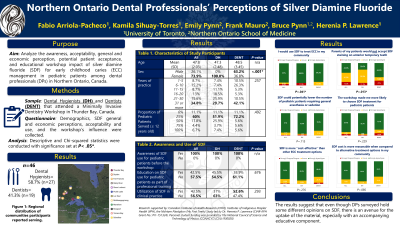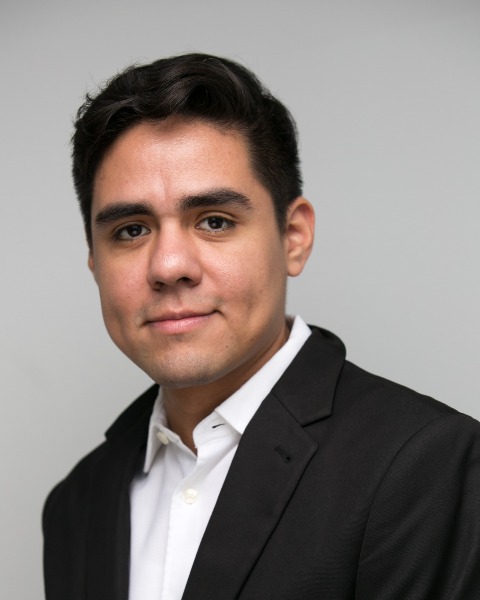Caries
518 - Northern Ontario Dental Professionals’ Perceptions of Silver Diamine Fluoride


Fabio G. Arriola-Pacheco, DDS, MSc (Pediatric Dent.) (he/him/his)
PhD Student
University of Toronto
University of Toronto
Toronto, Ontario, Canada- JS
Jessy Kamila Sihuay-Torres, D.D.S., MPH, Ph.D.(s)
University of Toronto
- EP
Emily Pynn, BSc, M.D.(s)
Northern Ontario School of Medicine
- FM
Frank Mauro, D.D.S, M.Sc.
Northern Ontario School of Medicine
- BP
Bruce Pynn, D.D.S, M.Sc.
Northern Ontario School of Medicine
- HL
Herenia P. Lawrence, D.D.S., M.Sc., Ph.D.
University of Toronto
- HL
Herenia P. Lawrence, D.D.S., M.Sc, Ph.D
Associate Professor, Dental Public Health Discipline
University of Toronto
Toronto, Ontario, Canada
Presenting Author(s)
Co-Author(s)
Program Director(s)
Purpose: Analyze the awareness, acceptability, general and economic perception, potential patient acceptance, and educational workshop impact of silver diamine fluoride (SDF) for early childhood caries (ECC) management in pediatric patients among dental professionals (DPs) in Northern Ontario, Canada.
Methods: A 42 item structured questionnaire was administered to volunteer attendees of a minimally invasive dentistry workshop in Thunder Bay, Canada. Respondents’ demographics, SDF general and economic perceptions, acceptability and use, and the workshop’s influence were collected. For this analysis, only pediatric-oriented items of the questionnaire were included. Descriptive and Chi-squared statistics were conducted with statistical significance at P < .05.
Results: Forty-six DPs, including hygienists (58.7%) and dentists (41.3%) participated. All DPs had heard of SDF before the engagement, but less than half had used it (43.5%). Certain differences amongst DPs arose, as hygienists were more likely: to choose SDF to treat ECC compared to dentists (P=.041) and to agree that their patients’ parents would accept staining in their children’s anterior teeth (P=.013). A majority (84.4%) of participants agreed that the workshop had made them more likely to choose SDF to treat ECC. Finally, participants perceived that SDF was cost-effective (78.3%) and had a reasonable cost when compared to their current treatment options (80.4%).
Conclusions: The results suggest that even though DPs surveyed hold some different opinions on SDF, there is an avenue for the uptake of the material, especially with an accompanying educative component.
Identify Supporting Agency and Grant Number:
Research supported by: Canadian Institutes of Health Research (CIHR), Institutes of Indigenous Peoples’ Health (IIPH), the Nishtam Niwiipitan (My First Teeth) Study led by Dr. Herenia P. Lawrence (CIHR-IIPH Grant No.: PI1-151324). Personal student funding was provided by The National Council of Science and Technology of Mexico (CONACYT) (CVU: 930020).

.jpg)